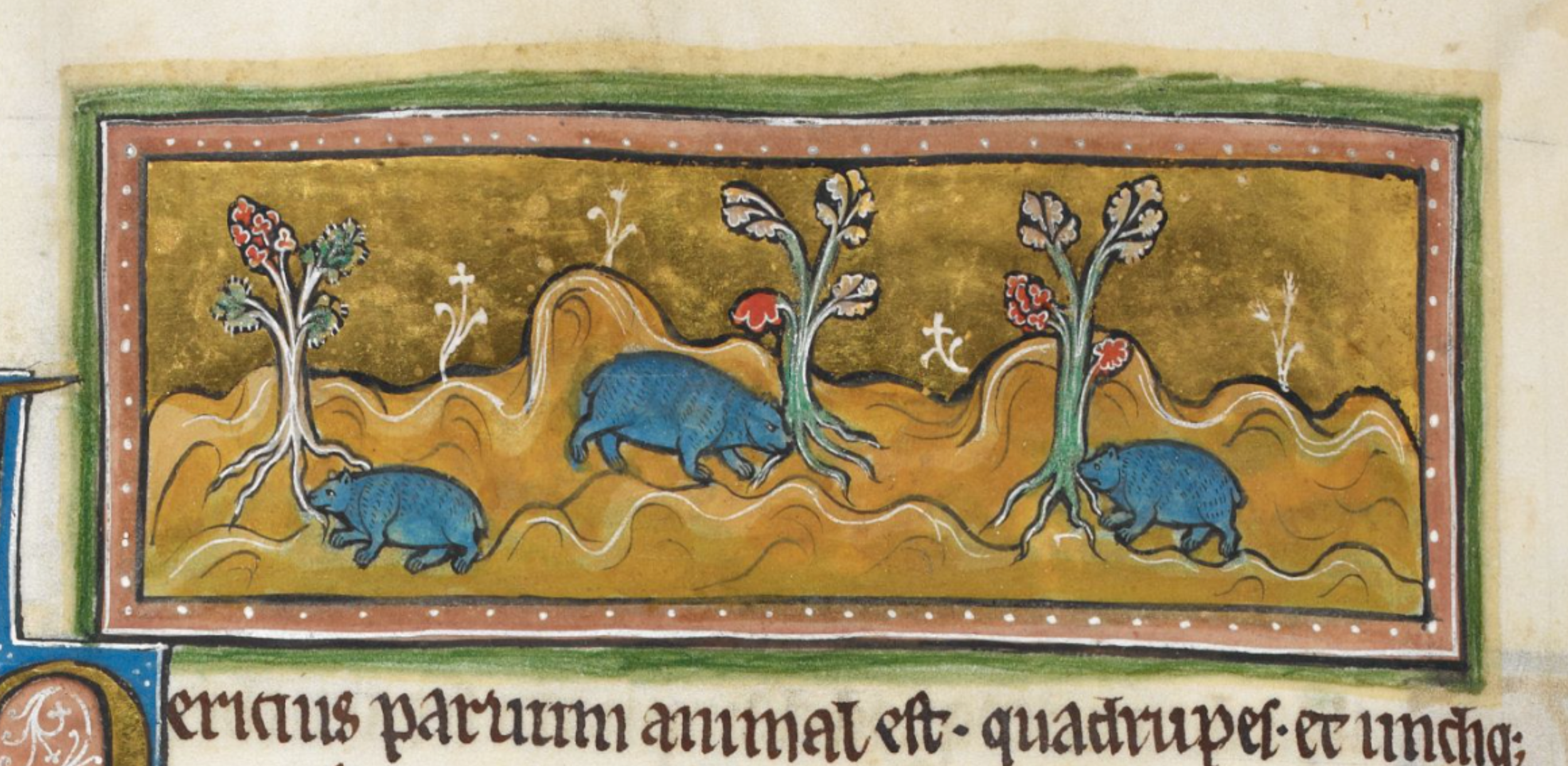
Mole, Rochester Bestiary, c.1230
Search page
Search within this page here, search the collection page or search the website.
Index
Weasel, Rochester Bestiary, c.1230
Laurel, Rochester Bestiary, c.1230
Mole, Rochester Bestiary, c.1230
The humble mole emerges as a potent allegory, condemned to eternal darkness by its very nature. This small, sightless creature, perpetually engaged in its subterranean pursuits, embodies the insidious traits of greed and avarice. With its earthy domain as its kingdom, the mole ceaselessly burrows, devouring the roots of herbs and grains from beneath, its very existence a testament to its voracious appetite.
In the profound words of Isaiah, the mole finds its spiritual resonance. "In that day a man will cast away his idols of silver And his idols of gold, Which they made, each for himself to worship, To the moles and bats" (Isaiah NKJV 2:20).

In the prophetic vision, the idols of silver and gold, once revered as embodiments of eloquence and wisdom, are now discarded, relegated to the realm of darkness alongside the moles and bats. These creatures, both blind in their own ways, represent the twin vices of avarice and false doctrine, luring humanity into the shadows of ignorance and idolatry.
Thus, the mole serves as a warning against the pitfalls of earthly desires and spiritual blindness. In its ceaseless digging and insatiable hunger for earthly treasures, it reflects the darker impulses that lurk within the human heart. As we tread the path of enlightenment, we must heed the lessons of the mole, casting aside the idols of greed by embracing the truth.
F44r
tate perpetua. Est enim animal parvum. quadru-
pes. absque oculis. semper terram fodiens. et eiciens;
subter fodiendo. et radices herbarum et frugum.
subter comedens. Super terram non diu vivere pt.
et habet pedes quasi manus cum digitis ut facilius
terram eruat. Significat cupidum. avarum. ter-
ram fodientem. Unde et ysaias dicit de primo adven-
tu christi. In die illa proiciet homo ydola argenti sui.
et simulacra auri fui. que fecerat sibi ut adhoraret
talpas. et vespertiliones. Simulacra auri et argenti sunt;
figmta eloquentie et sapiencie prophetorum. in quibus conside-
bant adhorantes talpas id est avariciam. que est. ydolorum
servitus. et vespertiliones id est ceca et falsa dogmata. que
veritatis luci non appropinquant. sed ignorantie te-
nebras amant;
It is called a mole, for it is condemned to darkness by perpetual blindness. It is a small animal, a quadruped without eyes, always digging and throwing out the earth; by digging below, it consumes the roots of herbs and grains from beneath. Above ground, it cannot live long and has feet resembling hands with fingers wherewith it digs the earth easily. The mole signifies greed, avarice, digging into the earth. Hence, Isaiah speaks of the first coming of Christ: “In that day mankind will cast away their idols of silver and their idols of gold, which they made for themselves to worship, to the moles and to the bats (Isaiah ESV 2:20)”. The idols of gold and silver are the images of eloquence and wisdom of the prophets, wherein there are engrossed those worshipping moles, that is, avarice, which is the submission to idols, and bats, that is, blind and false doctrines, which do not approach the light of truth but love the darkness of ignorance.
Bibliography
David Badke, The Bestiary Blog: Animals in the Middle Ages, Mole, November 6 2023, https://bestiary.ca/beasts/beast216.htm
Josh Goldenberg (BA 2012) and Matt Shanahan (BA 2014), Logeion, November 2022, https://logeion.uchicago.edu/
Castiglioni, L. and Mariotti, S. (1996). Vocabolario della Lingua Latina: Latino-Italiano Italiano-Latino. Terza Edizione. Loescher Torino
Matthews, J. and Matthews C., (2010), The Element Encyclopedia of Magical Creatures, HarperCollins UK, London
Curley, M. J., Physiologus: A Medieval Book of Nature Lore (University of Chicago edition 2009)
Rackham, H., M.A., Pliny Natural History Volume III, Libri VIII-XI (London: William Heinemann Ltd, 1949)
Collins, A. H., M.A., Symbolism of Animals and Birds (New York: McBride, Nast & Company, 1913)
Henderson, C., The Book of Barely Imagined Beings (London: University of Chicago Press, 2013)
White, T. H., The Bestiary: A Book of Beasts (New York: G.P Putnam’s Sons, 1960)
Barney, S. A., Lewis, W. J., Beach A., Berghof O., The Etymologies of Isidore of Seville (New York: Cambridge University Press, 2006)
